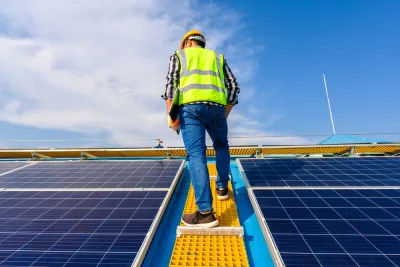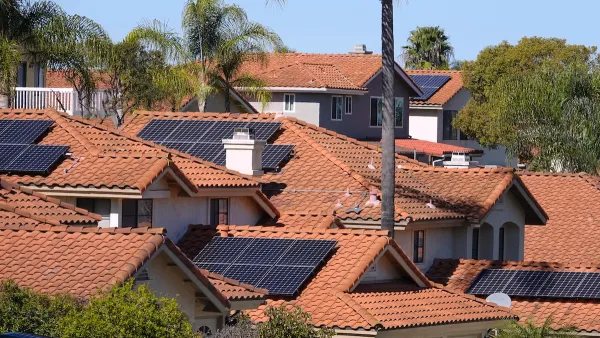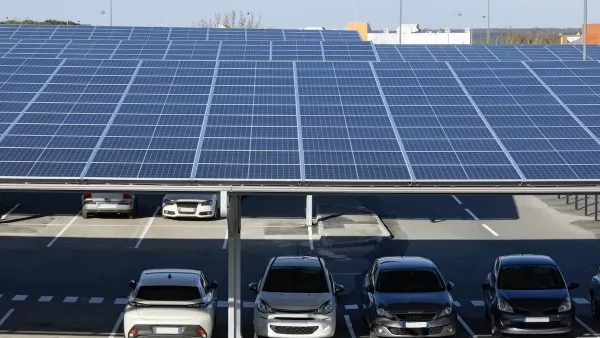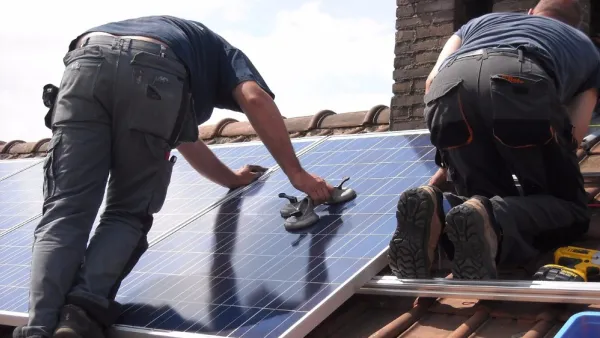Requirements in the NYFD fire code make it costly and difficult to achieve the city’s solar installation goals.

As part of New York City’s plan to reduce emissions by 80 percent by 2050, the city “aims to install 1,000 megawatts of solar technology within the five boroughs by 2030, enough to supply 250,000 homes with electricity.” But so far, “NYC has a 70 megawatt solar gap to close this year alone in order to fulfill its 2030 goal,” reports Zoya Teirstein for Grist, hindered in large part by the city’s building and fire codes.
“[A]s of 2019, the city requires all new buildings and major renovations of existing buildings to include either solar panels or a green roof system. But putting a solar installation on every rooftop in the city isn’t easy — and especially on the rooftops of existing buildings.” At the heart of the conflict is a 2021 revision to the city’s fire code, which calls for “more access pathways around panels and railings around rooftops that have solar on them.” Despite this rule applying to new construction only, the city’s Department of Buildings has denied solar permits for existing buildings on this basis. The rules also designate solar panels as “serviceable equipment” that triggers requirements for walkways and guardrails.
“There’s been no communication with the industry. There’s been no public forum,” says T.R. Ludwig, CEO of Brooklyn Solarworks, citing 13 examples of projects rejected due to the new fire code. While solar companies can apply for variances, the process adds expense and time to the permitting process.
For its part, the city has made some changes to accommodate these concerns. “After conversations with stakeholders,” [Rachel Finkelstein, a senior policy advisor for the NYC Mayor’s Office of Climate and Environmental Justice] said, the Department of Buildings “no longer interprets this section of Code as requiring railings for solar installations. The fire code remains unchanged.”
FULL STORY: NYC wants more rooftop solar. Its fire code is getting in the way.

Analysis: Cybertruck Fatality Rate Far Exceeds That of Ford Pinto
The Tesla Cybertruck was recalled seven times last year.

National Parks Layoffs Will Cause Communities to Lose Billions
Thousands of essential park workers were laid off this week, just before the busy spring break season.

Retro-silient?: America’s First “Eco-burb,” The Woodlands Turns 50
A master-planned community north of Houston offers lessons on green infrastructure and resilient design, but falls short of its founder’s lofty affordability and walkability goals.

Test News Post 1
This is a summary

Analysis: Cybertruck Fatality Rate Far Exceeds That of Ford Pinto
The Tesla Cybertruck was recalled seven times last year.

Test News Headline 46
Test for the image on the front page.
Urban Design for Planners 1: Software Tools
This six-course series explores essential urban design concepts using open source software and equips planners with the tools they need to participate fully in the urban design process.
Planning for Universal Design
Learn the tools for implementing Universal Design in planning regulations.
EMC Planning Group, Inc.
Planetizen
Planetizen
Mpact (formerly Rail~Volution)
Great Falls Development Authority, Inc.
HUDs Office of Policy Development and Research
NYU Wagner Graduate School of Public Service




























